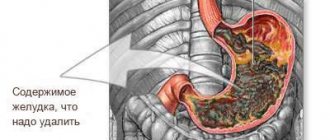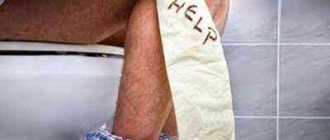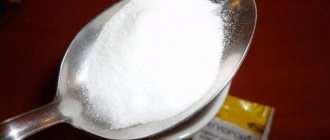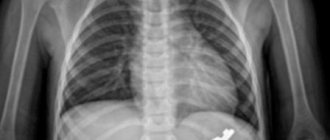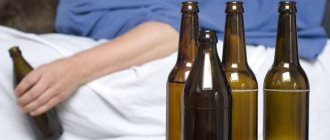Gastric lavage
In case of poisoning, gastric lavage is performed as part of first aid to the victim. The purpose of the procedure is to achieve a gag reflex to remove various toxic substances from the digestive system in order to prevent their further absorption into the blood. In some cases, vomit is used to diagnose diseases in gastrointestinal disorders. In an emergency situation, when intoxication threatens life, you can use the method at home. In a hospital, the procedure is carried out using a probe.
Indications and contraindications for gastric lavage
The lack of basic skills to independently cleanse the body of toxins and knowledge of medicine will only worsen the patient’s condition.
Let's first consider the cases when you can rinse the stomach:
- mild to moderate intoxication;
- increased acidity of gastric juice;
- intestinal obstruction;
- gastritis;
- secretion of mucus along with vomit;
- gallbladder dyskinesia.
And, of course, it is allowed to cleanse the body of toxins at home if it is known exactly what poisonous source provoked food intoxication.
There are also contraindications for forced gastric lavage:
- gastrointestinal bleeding;
- cardiovascular disorders;
- convulsions and paralysis;
- unconscious or pronounced coma;
- burns of the esophagus and larynx.
Gastric lavage will be useless if more than 5-6 hours have passed since food poisoning. In this case, any intervention is dangerous to the life of the victim.
Qualified medical care and subsequent intensive treatment in a hospital are required.
Manifestation of symptoms
Depending on what exactly caused the intoxication of the body, the manifestations can be completely different. But experts have identified a whole range of symptoms that indicate the development of this type of disorder.
Intoxication causes severe nausea and vomiting. An accompanying symptom is dyspepsia. Often a person experiences visual and hearing impairments. Problems arise with coordination of movements.
A characteristic symptom is a change in skin color. The skin becomes too pale and dehydration occurs.
During poisoning, both hypothermia and hyperthermia occur. Disturbances in the functioning of the respiratory organs often occur. There are problems with the cardiovascular and central nervous systems.
How to rinse the stomach in case of poisoning at home
There is no need for special medications or expensive drugs to cleanse the body. Everything you need is in your home medicine cabinet, kitchen or refrigerator. How is gastric lavage done?
In case of acute food poisoning, it is enough to drink 5-6 glasses of warm water. A saline or soda solution will do. It is prepared from 2 liters of warm boiled water, to which either 10 grams of salt or 4 grams of 1-2% baking soda are added.
Before each gastric lavage, it is recommended to dissolve 10-20 tablets of activated carbon in liquid and drink. This neutralizes poisons and toxins.
In case of drug poisoning, it is better to make a 0.02-0.1% solution of potassium permanganate to rinse the stomach. Avoid insoluble crystals or excessively purple water. For those who do not know how to dilute potassium permanganate, you should remember that only 2-3 grains per 2 liters of liquid are enough. The final color is pale pink.
Gastric lavage should be done with extreme caution in case of acid poisoning. In this case, until the ambulance arrives, only drinking plenty of fluids and rinsing the affected mucous membranes is recommended.
It is allowed to take orally a 1% solution of magnesium sulfate diluted in 200 ml of liquid. After poisoning with 80% vinegar, the stomach is washed with whole milk or a liter of cold water with the addition of 12 raw egg whites.
After deep poisoning with caustic alkalis, liquid is used to rinse the stomach. Tap water and milk will do. The alkali is neutralized by a solution of 2% acetic acid, a tablespoon of which is diluted in a glass of water. To prepare a remedy from citric acid, a teaspoon of powder is enough.
Gastric lavage after poisoning with technical liquids at home is also carried out with milk, activated carbon, laxative salt or water with whipped egg white. For poisoning with ethylene glycol and methanol, the antidote is to take a 30% solution of ethyl alcohol or 30-50 grams of vodka.
It is impossible to remove toxins on your own, so you cannot do without emergency doctors. Otherwise, death occurs.
To relieve alcohol intoxication, intensive rinsing with a soda solution will help. A teaspoon of baking soda is enough for a liter of water. An effective remedy for the treatment of poisoning and gastric lavage is Regidron powder. The contents of the package are diluted in a liter of warm water and provoke vomiting, cleansing the gastrointestinal tract of potent food poisons.
For safe gastric lavage, it is better for a child to use a water-salt solution. In case of poisoning, it is strictly forbidden to give potassium permanganate to children under 3 years of age. For newborns - 20 ml, for babies up to 2 months the recommended dose of liquid is 80 ml, up to 6 months - 100 ml, up to 9 months - 150 ml, up to one year - 200-250 ml. Children from 2 to 6 years old, respectively, up to 400 ml.
Food intoxication is dangerous due to possible subsequent dehydration and disruption of brain function. You should not risk your baby’s health and self-medicate. Only in a medical facility are doctors able to perform a safe procedure.
Post-intoxication period
To restore the functionality of organs and body systems after intoxication, you need to use solutions like Normohydron or Regidron. If it is impossible to buy such a solution, you can use ordinary mineral water without gas.
This will help restore the water-salt balance of the body. This method is called dehydration.
In severe forms of intoxication, dehydration is carried out in a hospital setting by administering solutions by intravenous drip.
To restore liver functionality, hepatoprotectors such as Essentiale and Karsila are used. And to restore the intestinal microflora - Linex, Bioflor, and other probiotics. After severe poisoning with mushrooms, alcohol or drugs, the victim is kept in the hospital until full recovery, while undergoing intensive symptomatic therapy.
In addition, for the entire recovery period after intoxication of any type, a gentle dietary diet must be prescribed, which excludes fried, spicy and canned foods, alcohol, carbonated drinks, and other foods that irritate the esophagus and stomach.
This diet should be based on stews, fish, boiled or steamed meat, viscous porridges, and jelly. Sometimes it is allowed to consume fermented milk products, but never whole milk.
After the procedure, it is necessary to continue treatment. In case of poisoning, an effective method is the use of sorbents. The most famous remedy of this kind is activated carbon. It is given to the patient at the rate of 1 tablet per 10 kg of weight. This medicine has the property of binding toxins, after which they are eliminated from the body naturally.
Sometimes white coal is used instead of regular coal. It is believed that this remedy acts more selectively and effectively. It also removes poisons, but at the same time retains beneficial substances. Dosage of white coal – 2-4 tablets for adults, depending on weight and degree of poisoning. Other sorbents are also used - Smecta, Polyphepan, Enterosgel.
In the future, patients are prescribed complete rest (bed rest) and plenty of fluids. If intoxication is accompanied by an increase in temperature and fever, the patient is covered with a blanket.
After the symptoms have decreased (a few days after the start of therapy), you can start taking drugs that normalize the intestinal microflora - Linex, Hilak Forte, etc. Antibiotics for poisoning are prescribed by a doctor in exceptional cases.
After completing first aid in a hospital or at home, the next step is the use of rehabilitation measures, carried out as prescribed by a specialist doctor, prescribed based on the results of tests, examination and additional studies in the form of ultrasound, x-rays.
They consist mainly in the use of a wide range of sorbents designed to relieve the effects of intoxication and remove decay products from the body by collecting waste and removing it through the body’s cleansing systems naturally.
Activated carbon is mainly used at the rate of one tablet per 10 kilograms of the patient’s weight. In addition, widely known medications are used: Smecta, Enterosgel.
In especially severe cases of poisoning, infusion therapy with solutions to detoxify the systems of the human body is used.
Gastric lavage technique
Sometimes, under the influence of toxic substances, the body’s defenses are weakened, the ability to eliminate toxins is reduced, and the gag reflex is absent. The victim develops severe pain and colic in the abdomen, and nausea begins.
You can relieve a person of unpleasant sensations as soon as you can properly rinse your stomach at home.
If the patient is able to independently reach the root of the tongue with two or three fingers and perform pressing movements, this is good. In cases where general health deteriorates, it is recommended to lay the victim on his side or sit him on a chair and hold his head so that he does not choke on vomit. The handle of a spoon is placed in the oral cavity. Prepare a container for secretions in advance.
Gastric lavage is done a little differently if a child has food poisoning at home. From the first month of life, fluid is administered using a syringe while lying on your side. Older children are seated on the lap of an adult and fixed in a motionless position. A spoon is used to induce vomiting.
How to induce vomiting with soda?
In case of poisoning, a gastric lavage solution can be easily prepared independently. For 1 liter of chilled boiled water add 1 tbsp. spoon of sodium bicarbonate. How to induce vomiting with soda:
- Give the victim 2 glasses of liquid to drink.
- Press with two fingers or a spoon onto the root of your tongue.
- Repeat the procedure 2-3 more times to ensure that the rinsing water does not contain food residues.
To reduce discomfort during vomiting, keep your head horizontal. This will prevent food from entering your nasal passages.
What to do after gastric lavage
Timely removal of toxins before the appearance of transparent masses and the absence of nausea in the patient indicates that the washing was done correctly. The next step will be to restore the digestive system and the affected mucous membrane.
How to treat the stomach after food poisoning.
"Festal" . Strengthens the functioning of the pancreas and intestines, normalizes digestion processes, improves the absorption of vitamins. Relieves diarrhea, flatulence and a feeling of heaviness in the stomach. Take 1-2 capsules 3 times a day. Be sure to take it during or after meals.
"Bifidumbacterin" helps restore intestinal microflora, increase the speed of digestion and improve metabolic processes. The drug contains bifidobacteria, which resist a large number of pathogenic and conditionally pathogenic microorganisms.
It is recommended to give a child up to 6 months after gastric lavage 1 packet, after six months - 1 packet 2 times a day, for children over 3 years and adults - 2 packets twice a day.
The herbal medicine "Filtrum-STI" helps cleanse the stomach and intestines of toxins, microorganisms, allergens and heavy metals. Prevents the development of diarrhea, has a sorbing and detoxifying effect, restores the microflora of the gastrointestinal tract. The daily dosage for adults is 12-16 tablets, for children - 4 grams.
In life you need to be prepared for anything. As for health, information about help in an emergency situation will not be superfluous. If there is a real threat to health and life, you should not hope that a medical professional will be nearby or an ambulance will arrive instantly. Any close person can intentionally or accidentally drink a chemical solution or pills that are not their own. You need to act immediately.
How to help a person perform gastric lavage in case of poisoning? Don't despair! You just need to remain calm and remember a few simple rules of conduct.
For small children
Doctors in children's hospitals prefer to use tube technology, since the likelihood of vomit entering the respiratory tract is minimized. The “restaurant” method is also recommended for older children (from 2 years old) and teenagers.
More interesting things on the topic
- First aid for poisoning in a child
- Detoxification properties of Sodium thiosulfate
- Providing first aid for insect bites
- Mushroom poisoning first aid
Practitioner. She graduated with honors from Vitebsk State Medical University in 2012 with a degree in general medicine. She was awarded a certificate of honor for her achievements in her work.
Let's work together to make the unique material even better, and after reading it, we ask you to repost it on a social network convenient for you. net.
Where does first aid for poisoning begin?
The thought of the possibility of poisoning should arise in relation to every person who is in a comatose state, when unreasonable convulsions appear, if his consciousness is confused.
First, try to find out what was drunk or eaten if the person is conscious and reacts adequately to the situation. If there is an assistant, let him urgently call an ambulance (the person will need to be taken to the intensive care unit in any case).
These first steps should be carried out as follows:
- the type of chemical that poisoned a person determines further treatment tactics;
- specialized assistance will definitely be needed, and it is not always possible to transport the victim to a hospital;
- sometimes, in trying to act independently, you can waste a lot of time and not save a person’s life;
In such situations, everyone is driven by a well-founded fear that the victim can be harmed or made even worse. But most often there is no time to think, so you will have to make every effort to help.
Dosage regimens
Intoxication is exposure to harmful substances that disrupt the proper functioning of the body. Toxins penetrate with low-quality food, liquids, and chemicals. It is advisable to take a soda solution at the first signs of poisoning.
Such poisoning occurs if the food was of poor quality or stale. Diarrhea, nausea, and pain in the stomach appear. To get rid of unpleasant consequences, a person uses a solution of sodium bicarbonate (bicarbonate).
How to prepare soda for food poisoning:
- pour hot purified water (necessarily boiled) into a half-liter jar or cup;
- add 2/3 teaspoon sodium bicarbonate;
- mix everything well until the substance dissolves;
- Cool to room temperature and drink all the liquid at once.
Important! You only need to use hot water, since soda does not dissolve well in a warm environment.
After 3-4 minutes, induce vomiting. To do this, you can place two fingers on the root of the tongue. To prevent dehydration after the procedure, you should constantly drink water.
A sumptuous feast often ends in poor health. This is alcohol poisoning. Intoxication can also occur after drinking low-quality alcohol. Toxic substances instantly penetrate the bloodstream and spread throughout the body. Therefore, action should be taken immediately. Signs of intoxication: dizziness, nausea with vomiting.
- take 1 liter of hot boiled water;
- add 1/3 tsp. salt and stir;
- add 1/3 tsp. main toxin-neutralizing substance;
- stir until dissolved, cool slightly, drink in one gulp.
You need to take small sips and then induce vomiting. If the procedure is carried out in a timely manner, most of the toxic substances will be released with vomit.
Poor quality or poisonous mushrooms are a dangerous product, and it is difficult to remove toxins absorbed into the blood. When the very first signs of poisoning appear, you should immediately call a doctor, and before his arrival, drink a solution based on sodium bicarbonate.
- take a cup of boiled hot water;
- add and stir well 2 tsp. soda (take more than in other cases to neutralize the strongest toxins);
- cool to a temperature of 36-37 °C, drink all the liquid in small sips.
After the procedure, induce vomiting. Then you need to lie down and wait for the ambulance to arrive.
Important! If you are poisoned by mushrooms, you should immediately seek help from a doctor. Intoxication can lead to death.
This is the most dangerous poisoning, since carbon monoxide instantly penetrates the blood and lungs. Due to lack of oxygen, a person begins to suffocate. If you don't get help in a timely manner, it could end in disaster.
Before the stomach cleansing procedure, it is important to provide first aid. To do this you should:
- take the victim to fresh air (street, balcony);
- if a person is unconscious, immediately call an ambulance, since in such situations hospitalization is required.
If the victim has not had time to inhale carbon monoxide and is conscious, after a while he should be offered to drink a glass of soda solution in which 1 tsp will be dissolved. substances.
To alleviate the condition, you can slightly rub the chest with a weak concentration of vinegar water.
In this case, a cough, excessive salivation, dizziness, convulsions, nausea, and respiratory arrest appear. The colorless substance envelops the mucous membrane of the respiratory system and causes swelling. When the lungs swell, the victim begins to choke.
You need to get out into the fresh air. The flow of oxygen will ease the condition and reduce dizziness. Before the doctors arrive, you need to drink a soda solution and wipe your temples and chest area with vinegar.
To prepare soda liquid, it is recommended to perform the following steps:
- pour hot boiled water into a glass;
- add 1 tsp. substance and stir until it is completely dissolved.
Give the victim a drink. After 7-10 minutes you can induce vomiting. Take a saline solution to prevent dehydration: stir 1 tsp in a cup of warm water. salt and soda.
If intoxication occurs as a result of taking an unknown poison, first aid can be provided at home. In case of such poisoning, soda is used, which will help neutralize toxins and improve the condition of the victim.
- add 0.5 tsp to a glass of hot water. sodium bicarbonate;
- mix well, let cool to room temperature and drink everything to the bottom.
Induce vomiting and lie on your side. Open the windows and doors for fresh air.
Options for gastric lavage at home
How to do gastric lavage at home? First, you need to remember all the possible medical lessons that you have ever taken in your life: mutual aid courses at school, specialized classes at a college or institute. Even a minimum of information can help. There are two main methods for cleaning the stomach at home:
- probeless method;
- gastric lavage using a tube.
Any of these benefits can be done at home. To do this, it is enough to have a small amount of liquid (water at room temperature, sodium chloride solution or other specific liquid for washing) and a gastric tube (this rubber tube can only be found in a specialized first aid kit of an ambulance, but sometimes, by luck, the victim or his assistants). It is advisable that the procedure be carried out by at least two people, so assistance will be provided faster and of better quality.
Tubeless gastric cleansing method
The probeless method is used if the poisoning is mild and the person is conscious. It is most often used in adults and older children. This method is also suitable for helping yourself.
How to perform such gastric lavage at home in case of poisoning, step by step:
- the victim immediately drinks from 500 to 700 ml of liquid or more;
- then the root of his tongue is irritated with a spatula or a regular spoon to provoke a gag reflex;
- if necessary, such actions are repeated.
Such help is especially indicated for people who have taken chemicals along with food. This method is recommended for use by conscious victims in case of any poisoning, except:
- acute gasoline poisoning;
- kerosene;
- turpentine;
- strong acids;
- alkalis;
- many oxidizing agents.
Such substances can re-damage the digestive and respiratory systems when passing back!
After this procedure, it is advisable to rinse the stomach additionally through a probe, since the toxic substance sometimes remains in the folds of the mucous membrane of the digestive organs and can cause harm.
Gastric lavage using a tube
This procedure will require special skills and additional equipment. As a last resort, you can use a printed manual or the help of a specialist (by calling a doctor you know or an ambulance). Gastric lavage through a tube at home is a relatively safe, but at the same time responsible procedure. If done incorrectly, complications are possible:
- rupture of the stomach, esophagus;
- vomit will enter the respiratory tract and lead to suffocation.
For the procedure, you will need a special gastric tube - this is a thick rubber tube with a diameter of 1 cm (a thin one can have a diameter of 4 or 5 mm) and a length of 70 cm. The end of the probe is rounded and has two holes.
If poisoning is suspected, the following procedure is performed.
- It is better to rinse when the affected person is in a sitting position. For this, the person is seated on a chair, the body is covered as much as possible with oilcloth.
- His head is tilted, you need to ask the victim to relax and not move his tongue.
- A probe is gradually introduced through the mouth (from the edge of the teeth to the sternum, namely, to its xiphoid process).
- It is important to make sure that the tube does not enter the trachea (breathing noises will be heard, a cough will appear, and the lips and facial skin will turn blue).
- The probe is inserted until gastric contents appear from the upper edge of the funnel, which will need to be taken for examination.
- Liquid is gradually introduced. How to rinse the stomach in case of poisoning? For adults, use ordinary water at room temperature, but not more than 18 °C; for young children, it is better to use saline solution.
- For one rinse, it is enough to pour 500–700 ml of water (this is the norm for an adult).
- The stomach is washed using a siphon: when pouring water, the funnel is located below the level of the stomach, then it is raised.
- After filling, the funnel is lowered, the rinsing water is drained and the stomach is filled with water again. This should be done until clear water appears. This procedure in general can take five liters or more.
Then the victim should be immediately taken to the hospital, regardless of his health. At the same time, do not forget the jar of gastric contents, which were collected in order to study its composition in the laboratory - this often saves a person’s life.
Emergency gastric lavage in case of poisoning is normally carried out by medical workers, but when it comes to the life of a loved one, there is no choice. The procedure itself is not complicated - the only problem is deciding to carry it out.
https://youtube.com/watch?v=3aGRaSD6g1o
The site provides reference information. Adequate diagnosis and treatment of the disease is possible under the supervision of a conscientious doctor.
Gastric lavage is a method of cleansing the body of toxins and poisons that have entered the stomach, and is more often used for acute poisoning. The procedure improves the patient’s condition, promotes a speedy recovery, and saves lives.
At the first symptoms of poisoning, according to treatment standards for infectious diseases, it is recommended to take the bactericidal enterosorbent PEPIDOL (2 tablespoons every 3 hours until the condition is completely normalized).
Features of diagnosis and treatment
Poisoning occurs quite often and can lead to very dangerous consequences. To prevent this, you need to do a rinse.
For this, water, potassium permanganate solution and other substances are used.
To avoid problems, you need to do the procedure correctly.
So, how to rinse the stomach in case of poisoning at home?
Indications for the procedure
Only a qualified doctor can diagnose food poisoning and prescribe treatment, after collecting an anamnesis, examining and examining the body.
Symptoms of food poisoning are not specific; they are also observed in other pathologies. For example, the flu can begin with fever, vomiting and diarrhea, and abdominal pain and flatulence can be signs of acute pancreatitis.
Dietary nutrition is very important in the treatment of poisoning. It helps restore the functioning of the digestive system. The list of permitted and prohibited products should be discussed with your doctor. When preparing a diet, you need to take into account the individual characteristics of each patient, his concomitant diseases (for example, diabetes or food allergies).
Below are the basic rules of diet therapy for food poisoning.
During treatment, food should be consumed frequently and in small portions. It is best to eat every 2 hours.
The food temperature should be neutral. Hot and cold will irritate the gastric mucosa.
It is strictly forbidden to eat fried, spicy and fatty foods, drink alcohol and carbonated drinks. It is best to steam or boil food.
After 5-7 days, you can diversify the patient’s diet with stewed or oven-baked dishes. When preparing dishes, you can only use vegetable oil, salt and sugar.
Animal fats and hot spices should be avoided during the period of treatment and recovery.
chicken broth prepared without spices; oatmeal, rice and buckwheat porridge cooked in water; boiled vegetables; bananas; baked apples; dried white bread; biscuits; lean varieties of meat and fish.
During treatment, it is forbidden to eat fatty meats, chips, offal, and store-bought convenience foods. You should also give up coffee, strong tea, freshly squeezed and store-bought juices, chocolate, and confectionery.
Diet and pills for food poisoning are prescribed by your doctor. Self-medication is prohibited.
Treatment is selected by the doctor based on examination of the patient, collection of anamnesis and laboratory and instrumental examination. In case of mild poisoning, a person can take medications at home, while following all the recommendations of the attending physician.
In addition to taking medications, you need to adhere to a diet. It helps the digestive system recover and begin to function fully.
In what cases should the stomach be washed?
- Acute poisoning with food, mushrooms, medicines, alcohol.
- Narrowing of the gastric outlet
- Decreased tone of the muscle wall of the stomach or duodenum
- Intestinal obstruction
- When toxic substances are released into the lumen of the stomach. For example: urea secretion in chronic renal failure.
Contraindications
- Organic narrowing of the esophagus
- Acute bleeding from the esophagus or stomach
- Severe burns of the larynx, esophagus, stomach with acids and alkalis
- Cerebrovascular disorders
- Myocardial infarction, unstable angina, severe heart rhythm disturbances
- Unconscious state (without prior intubation). Intubation is the insertion of a special tube into the larynx and trachea to maintain patency of the airways and maintain respiratory activity.
- Absence of cough or glottal reflex
- Convulsions, convulsive state
Medicines for nausea
Prolonged nausea occurs due to irritation of the gastric mucosa by toxins, poor quality food, and chronic inflammation of the gastric wall. To remove toxic substances during long-term intoxication with low levels of alcohol, it is recommended to use natural sorbents: chitin, fiber, cellulose.
Chitin and cellulose tablets can be purchased at the pharmacy. The drug is used for diabetes mellitus and atherosclerosis. Prescribed before meals to maximize the binding of toxic compounds.
Sorbents
Enzymes
Antispasmodics
Methods of gastric lavage
- Rinsing without using a probe
- Flushing using a thick probe
- Flushing using a thin probe
Gastric lavage without using a tube (“restaurant method”)
- If the patient cannot swallow the tube, then he can drink water on his own and then induce vomiting, thus emptying the stomach.
- You should drink in portions of up to 500 ml at a time. Then expect vomiting or stimulate it. In total, about 5-10 liters of water are required for effective gastric lavage.
What is needed for rinsing?
- Wash solutions:
- Pure boiled water (20-24°C). Water for rinsing should not be hot, as it can dilate blood vessels and enhance the absorption of toxins, nor cold, which can cause stomach spasms.
- Saline solution (2 tablespoons per 5 liters of water). Prevents the movement of toxins and poisons further into the intestines, causing spasm of the gastric outlet sphincter.
- Light solution of potassium permanganate (potassium permanganate). Make sure that there are no small crystals of potassium permanganate left by stirring the solution well or filtering it. Since crystals can get on the mucous membrane of the esophagus and stomach and cause a burn. Potassium permanganate binds toxins and also has an antiseptic and antimicrobial effect.
- Soda solution (2 tbsp per 5 liters of water).
- Means for collecting rinsing water (basin, bucket, etc.). The rinsing water must be shown to emergency doctors, this will help in diagnosing the disease.
- Protective equipment for those helping the patient (waterproof apron, gloves). Vomit may contain viruses, bacteria, poisons and toxins that can enter the body and cause various diseases (for example: intestinal infection or viral hepatitis).
How to do it?
- You can't induce vomiting! In case of poisoning with strong acids, alkalis, turpentine, vinegar essence, bleaches, bath and toilet cleaners, furniture polish. In these cases, gastric lavage with a tube should be used.
Is it possible to get poisoned by soda solutions?
If you use sodium bicarbonate uncontrollably, in large doses and for a long time, the substance can cause intoxication. This is fraught with alkalization of the blood - alkalosis.
The disease is characterized by:
- diarrhea;
- cardiopalmus;
- thirst;
- nausea;
- poor appetite;
- stomach cramps.
Increased nervousness, dizziness, and even convulsions may occur. To prevent alkalosis, you should immediately drink a couple of cups of milk or grape juice.
To eliminate the consequences of poisoning, urgent measures must be taken. Soda solution should be used rarely and in the recommended dosage, otherwise it can cause irreparable harm to the body.
Improperly stored foods, mushrooms, alcohol are only a small part of what causes digestive system upset. In case of poisoning, soda is an indispensable “lifesaver” for providing first aid.
Let us remind you how to properly rinse the stomach with soda, what scheme is used to use sodium bicarbonate for a hangover and acute alcohol intoxication.
Gastric lavage using a thick tube
What is needed for rinsing?
- Gastric lavage tube; The probe itself is a tube made of a rubber mixture 80-120 cm long, a thick probe with a diameter of 10-13 mm, a thin one 5-9 mm. One end is cut off and the other is rounded and has side holes.
- Rinse solution (5-10 liters)
- Pure boiled water (20-24°C). Water for rinsing should not be hot, as it can dilate blood vessels and enhance the absorption of toxins, nor cold, which can cause stomach spasms.
- Saline solution (2 tablespoons per 5 liters of water). Prevents the movement of toxins and poisons further into the intestines, causing spasm of the gastric outlet sphincter.
- Light solution of potassium permanganate (potassium permanganate). Make sure that there are no small crystals of potassium permanganate left by stirring the solution well or filtering it. Since crystals can get on the mucous membrane of the esophagus and stomach and cause a burn. Potassium permanganate binds toxins and also has an antiseptic and antimicrobial effect.
- Soda solution (2 tbsp per 5 liters of water).
- Important! Correctly calculate a single dose of infusion (5-7 ml per 1 kg of patient’s body weight). The simultaneous introduction of a large volume of liquid into the stomach promotes its entry into the intestines.
- Funnel with a capacity of 500ml-1 l, mug
- Towel, napkins
- Container for rinsing water
- Gloves, waterproof apron
- Vaseline oil or glycerin
How to do it?
- Make sure the tube goes into the stomach
Options:
- The beginning of the release of gastric contents when the tube is lowered below the level of the stomach
- Using a Janet syringe, inject 20 ml of air into the stomach, while listening with a phonendoscope or directly leaning your ear against the abdominal wall in the stomach area for characteristic sounds.
- Draw the contents from the stomach into a syringe
- Attach the funnel to the probe , then, holding the funnel at the level of the stomach, pour 500-1000 ml of water into it.
- Then slowly raise the funnel to the level of the face or above the level of the stomach (if the patient is lying down).
As soon as the water reaches the level of the mouth of the funnel, lower the funnel below the level of the stomach, then the contents of the stomach will begin to pour into the prepared container for collecting rinsing water. The first portion of rinsing water is sent for laboratory testing. https://youtube.com/watch?v=3aGRaSD6g1o
Gastric lavage using a thin gastric tube
What is needed for rinsing?
Vaseline oil or glycerin
- Pure boiled water (20-24°C).
- Saline solution (2 tablespoons per 5 liters of water).
- Light solution of potassium permanganate (potassium permanganate)
- Soda solution (2 tbsp per 5 liters of water).
- Glass with water (50ml) and drinking straw
- Syringe Janet
- Band-Aid
- Towel, napkins
- Gloves
- Container for washing water (basin, bucket, etc.)
- 5-10 liters of rinsing solution

